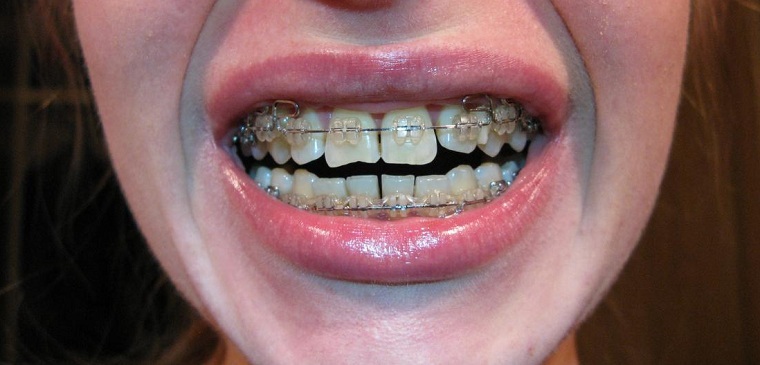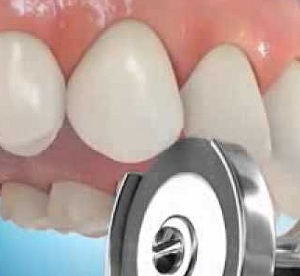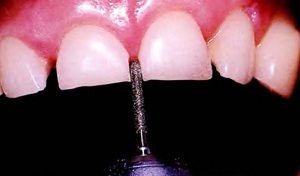 Modern orthodontics offers a huge number of methods of bite correction. Many of them are painless and allow you to get a beautiful smile.
Modern orthodontics offers a huge number of methods of bite correction. Many of them are painless and allow you to get a beautiful smile.
These methods include the separation of teeth or in other words turning the enamel to obtain the necessary space for alignment of the dentition.
Contents
- Dental separation and its types
- Indications and contraindications
- How is the operation performed?
- Advantages and disadvantages of
- Practical experience of
- Cost of orthodontics services
Dental separation and its types
In dentistry, the name of the separation is the procedure, during which the tooth is turned from the sides to expand the space between them. Usually the thickness of the removed layer of enamel does not exceed 0.25 mm. A technique is used for effective treatment of congestion of teeth and correction of occlusion. As a result of turning, there is a space for aligning molars or incisors, and therefore there is no need to remove healthy teeth.
Now separation is considered the most sparing, but at the same time effective method of bite correction. The procedure allows you to purchase a beautiful smooth smile even for people who are not ready to part with healthy teeth. Since the enamel layer that is removed does not exceed a quarter of a millimeter, the sensitivity of the teeth does not increase after the procedure.
Depending on the technology of separation, there are two types:
- mechanical - removal of enamel with special tools;
- physiological - expansion of the space between the teeth by installing special spacers for a certain period of time.
The type of influence is selected by the orthodontist, taking into account the complexity of the problem and the individual characteristics of the patient.

Bracket separation
Indications and contraindications
During the separation, the shape and position of the tooth changes, the space for its movement or adjacent incisors( molars) appears. In connection with this indication for the procedure are:
- correction of bite and alignment of the dentition;
- installation of crowns and bridges;
- disorders in the development and eruption of the tooth.
Contraindications for separation are:
- caries;
- gum disease;
- pulpitis or other dental disease.
In the presence of contraindications, the first treatment of teeth or gums, and after the orthodontic manipulation.
How is the operation performed?
For mechanical separation, the enamel layer is removed in places where the teeth come into contact. Special tools are used for these purposes:
- nail file;
- single-sided or double-sided disc.
Specialists believe that the use of a special disk is more effective and safe, since the tip allows the  to secure its position.
to secure its position.
When sharpening the teeth, the orthodontist gently pushes the soft tissues with the oral mirror. This helps prevent their damage and the development of inflammatory processes.
After removing the enamel layer, the specialist grinds the tooth, eliminating the sharpness of the corners, which can cause discomfort and lead to damage to the soft tissues of the oral cavity. To avoid the appearance of excessive sensitivity to the treated tooth surface, a special composition is applied.
The technique of physiological separation differs from mechanical separation. A specialist in the natural cracks between the bored teeth inserts special wedges. To widen the space between the teeth, usually 1 day is enough. The period of wearing the wedges determines the orthodontist, depending on the complexity of the problem and other nuances.
Pros and Cons of
Teeth separation is gaining in popularity as it has important advantages:
- eliminates the need to remove healthy teeth to correct bite and crowding;
- procedure allows you to get enough space for manipulating the alignment of the dentition, for the installation of prosthesis or teething;
- no rehabilitation period - after visiting an orthodontist, the patient can do the usual things and do not change his habits;
- there is no need for restoration of dental tissue;
- procedure is painless, only unpleasant sensations can arise;
- procedure does not take much time and is easy to conduct;
- , with proper performance, ensures the absence of injuries to the mucous and soft tissues, as well as other unpleasant consequences.
 Among modern orthodontic methods, separation is considered the most gentle procedure, which allows you to get rid of crowding without removing lateral teeth.
Among modern orthodontic methods, separation is considered the most gentle procedure, which allows you to get rid of crowding without removing lateral teeth.
Separation of teeth has no significant disadvantages, there are no significant limitations for the conduct and unpleasant consequences. The only disadvantages are the following:
- increase in sensitivity;
- pulp integrity failure;
- is a local inflammatory process of the gums.
Similar phenomena usually arise due to improperly performed procedures and low qualification of the doctor. To avoid such troubles, it is necessary to approach the choice of clinic and specialist with all responsibility. It is better to seek help from a doctor who has experience of such manipulations.
Practical experience of
In most cases, patients' reviews of dental separation are positive. Some people note that tooth decay appeared on the treated areas, but experts say that such a situation is the result of improper or insufficient dental care, and not the procedure itself.
I was separated before installing the bracket system. Very worried that there will be sensitivity, since the enamel is removed, but I did not notice anything like this, although it's been 2.5 years since the procedure. I was very pleased with the result, so I recommend it to everyone. This is an effective and painless way to get a beautiful smile.
Marina, 21 year
I did not dare to go into separation for a long time, afraid of negative consequences( I read about them on the Internet).The orthodontist convinced the need for the procedure and its safety.
It's been 5 years already, but I never regretted that I still agreed to the separation. The procedure is painless, tooth sensitivity and other problems have not appeared. Now I can smile without wide embarrassment, because my teeth are even and beautiful.
Victoria, 30 years
Cost of Orthodontist services
The price for the separation of one tooth varies from 400 to 600 rubles. The cost depends on several factors: 
- clinics;
- qualification specialist;
- region;
- used techniques and tools.
Separation of teeth is an excellent, sham-saving alternative to removal.
This is a new word in orthodontics, which allows you to get even teeth and a beautiful smile without losing healthy teeth.
